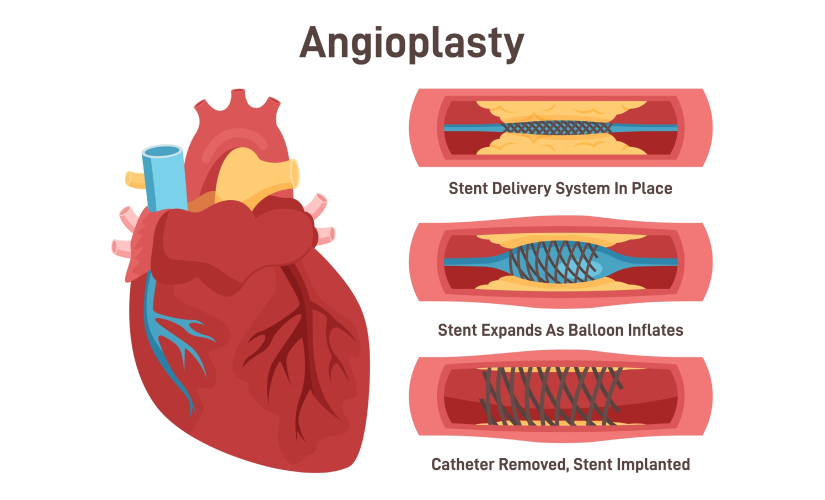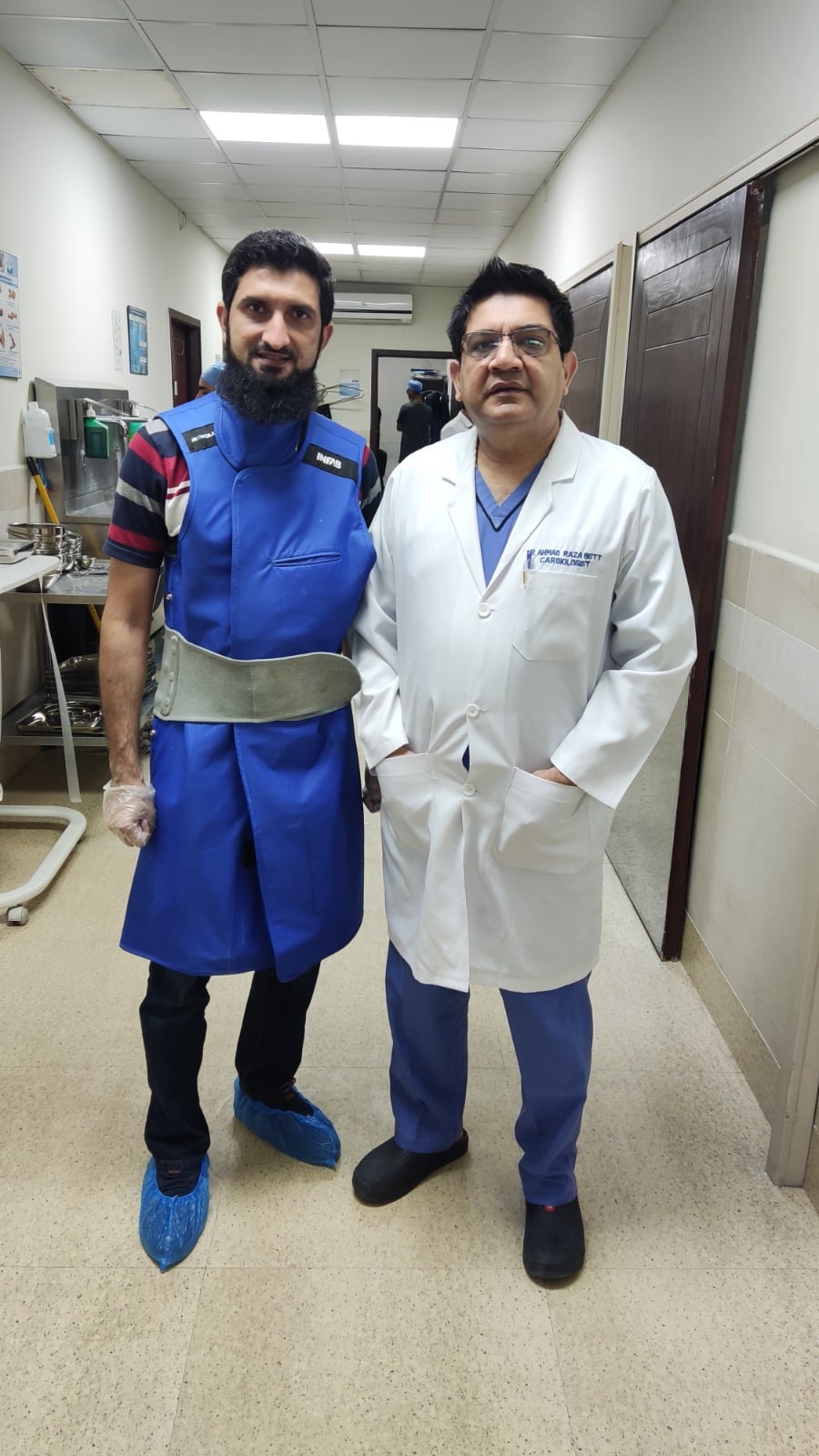Angioplasty is generally a safe procedure, but it does carry some risks and potential complications. Bleeding or bruising can occur at the catheter insertion site, typically in the groin or wrist, and there is a possibility of damage to the blood vessels during the procedure. Some patients may have allergic reactions to the contrast dye used, which in rare cases can be severe. The dye can also affect kidney function, especially in individuals with pre-existing kidney problems. There is a risk of the treated artery narrowing again, known as restenosis, although this is less common with modern drug-eluting stents. Blood clots can form in the artery or on the stent, which might increase the chance of a heart attack, so blood-thinning medications are usually prescribed. Though rare, angioplasty can sometimes trigger a heart attack or a stroke during or shortly after the procedure. Additionally, irregular heart rhythms, infections at the catheter site, and serious complications like tearing or rupture of the artery wall can occur. Patients are advised to monitor for symptoms such as severe chest pain, heavy bleeding, or signs of stroke after the procedure and seek immediate medical attention if these arise.
Home / Services
ANGIOPLASTY
Understanding Angioplasty: Life-Saving Procedures in Cardiac Care
Understanding Cardiac Emergencies and the Role of a Consultant Cardiologist
Angioplasty is a minimally invasive medical procedure used to open narrowed or blocked arteries, most commonly in the heart, to restore proper blood flow. It is frequently performed in patients with coronary artery disease, where plaque buildup restricts blood flow and can lead to chest pain, shortness of breath, or heart attacks. During the procedure, a thin catheter with a small balloon at its tip is inserted into a blood vessel, typically through the groin or wrist, and guided to the site of the blockage. Once in place, the balloon is inflated to compress the plaque against the artery walls, widening the artery. In many cases, a small wire mesh tube called a stent is also placed to keep the artery open permanently. Angioplasty offers quicker recovery times compared to open-heart surgery and effectively relieves symptoms, but it carries some risks, such as bleeding, vessel damage, or re-narrowing of the artery.
Angioplasty – Advanced Cardiac Solutions
Angioplasty is a minimally invasive procedure used to open narrowed or blocked arteries, typically caused by a buildup of plaque, and restore normal blood flow to the heart. At Advanced Cardiac Solutions, angioplasty is performed using the latest technology and techniques to ensure precision, safety, and effective outcomes for patients with coronary artery disease. The procedure involves threading a small balloon-tipped catheter through the blood vessels to the affected artery, where the balloon is inflated to widen the artery and often followed by the placement of a stent to keep it open. Advanced Cardiac Solutions is committed to providing personalized care, combining expert cardiology with cutting-edge tools to reduce recovery time and improve long-term heart health.
Angioplasty is a medical procedure used to open narrowed or blocked blood vessels, usually arteries, to restore normal blood flow. It is most commonly performed to treat coronary artery disease, a condition where the arteries supplying blood to the heart become narrowed due to plaque buildup. During the procedure, a thin tube with a small balloon at its tip is inserted into a blood vessel, often through the wrist or groin, and guided to the site of the blockage. The balloon is then inflated to widen the artery, improving blood flow. In many cases, a small wire mesh tube called a stent is also placed in the artery to help keep it open. Angioplasty helps relieve symptoms like chest pain and can reduce the risk of heart attack, offering a less invasive alternative to bypass surgery.
Angioplasty is a minimally invasive medical procedure used to open narrowed or blocked blood vessels, typically coronary arteries, to restore blood flow to the heart muscle. Here’s a step-by-step overview of how angioplasty is done:
🩺 1. Preparation
The patient is typically awake but sedated.
Local anesthesia is applied to numb the insertion site (usually the groin or wrist).
An intravenous (IV) line is placed to give medications or fluids.
🧭 2. Insertion of the Catheter
A sheath (a short, thin tube) is inserted into an artery.
A guide wire is threaded through the sheath to the blocked artery.
A catheter (a long, thin tube) with a deflated balloon at its tip is guided over the wire to the site of the blockage using fluoroscopy (real-time X-ray imaging).
🎈 3. Balloon Inflation
Once the catheter is in position, the balloon is inflated.
The inflation compresses the plaque (fatty deposits) against the artery wall, widening the artery and restoring blood flow.
The balloon is then deflated and sometimes removed.
🧱 4. Stent Placement (if needed)
In most cases, a stent (a small wire mesh tube) is mounted on the balloon catheter.
When the balloon is inflated, the stent expands and locks into place inside the artery.
The balloon is deflated and removed, but the stent remains permanently to keep the artery open.
🔚 5. Finishing Up
The catheter and sheath are removed.
Pressure is applied to the insertion site to prevent bleeding.
A closure device may be used to seal the artery.
The patient is monitored for a few hours or overnight.
🧑⚕️ Recovery
Patients are usually observed for a few hours to a day.
Light activities are allowed in a few days; full recovery may take a week.
Blood thinners (e.g., aspirin, clopidogrel) are prescribed to prevent cloting.
Medical Precautions & Evaluation
Medical History Review:
Inform your doctor of all existing medical conditions (e.g., diabetes, kidney disease, bleeding disorders).
Discuss any past reactions to contrast dye, anesthesia, or iodine.
Medications:
List all medications, including over-the-counter drugs and supplements.
You may need to stop blood thinners (e.g., warfarin, aspirin, clopidogrel) a few days before the procedure unless advised otherwise.
Antiplatelet therapy (like aspirin and clopidogrel) is often continued if a stent is planned.
Allergy Check:
Let your healthcare provider know if you have allergies to contrast dye, shellfish, iodine, or latex.
Blood Tests & Imaging:
You may undergo blood tests (e.g., kidney function, clotting profile) and imaging (like ECG, echocardiogram, or angiogram) before the procedure.
🍽️ Dietary & Lifestyle Precautions
Fasting:
Do not eat or drink anything 6 to 8 hours before the procedure (as directed by your doctor).
Smoking and Alcohol:
Stop smoking and avoid alcohol at least 24 hours before the procedure.
🏥 Day of Procedure:
Bring Essentials:
Bring your ID, insurance info, and list of medications.
Wear loose, comfortable clothing and remove jewelry.
Arrange Transportation:
You will not be able to drive after the procedure. Arrange for someone to take you home.
Consent Form:
You’ll be asked to sign a consent form after the doctor explains the risks, benefits, and alternatives.
⚠️ High-Risk Patients
Special precautions are taken for patients with:
Chronic kidney disease: Risk of contrast-induced nephropathy.
Diabetes: Particularly if taking metformin, which may need to be paused.
Bleeding risk: May need special preparation regarding anticoagulation.
Angioplasty is performed to open narrowed or blocked blood vessels, typically arteries, that supply blood to the heart or other parts of the body. This procedure helps restore proper blood flow, which is essential for delivering oxygen and nutrients to tissues. It is commonly used to treat conditions like coronary artery disease, where plaque buildup restricts blood flow and can lead to chest pain (angina) or heart attacks. By inflating a small balloon inside the artery, angioplasty widens the vessel, often followed by placing a stent to keep it open. This minimally invasive technique improves symptoms, reduces the risk of serious heart problems, and enhances overall heart function, making it a crucial treatment option for many patients with cardiovascular disease.
Provides detailed, real-time images of blood vessels for accurate diagnosis.
Helps precisely locate blockages, narrowing, or abnormalities in arteries and veins.
Guides treatment decisions, including the need for angioplasty or surgery.
Minimally invasive compared to traditional surgical exploration.
Involves less risk, less pain, and quicker recovery for patients.
Can be combined with therapeutic procedures like angioplasty or stent placement during the same session.
Enhances early detection and effective management of vascular diseases.
Common Side Effects:
Bruising or bleeding at the catheter insertion site (usually the groin or wrist)
Soreness or discomfort at the insertion site
Allergic reactions to the dye used during the procedure (rare)
Possible Complications (less common but serious):
Blood clots that could cause a heart attack or stroke
Damage to the artery or blood vessel (dissection or rupture)
Restenosis (re-narrowing of the artery after the procedure)
Kidney damage from the contrast dye (especially if you have pre-existing kidney problems)
Irregular heart rhythms (arrhythmias)
Infection at the catheter site (rare)
Heart attack during or shortly after the procedure (very rare)
Bleeding inside the body or at the insertion site requiring intervention
Healing after angioplasty typically involves a careful recovery process where the artery gradually stabilizes following the procedure. The goal is to allow the blood vessel to heal around the newly placed stent or the area where the artery was widened. Patients are usually prescribed medications such as antiplatelets to prevent blood clots and reduce the risk of restenosis (re-narrowing of the artery). Follow-up care is crucial and includes regular monitoring through clinical visits, imaging tests like stress tests or angiograms, and lifestyle modifications to support heart health. During follow-up, doctors assess how well the artery is healing, check for any complications, and adjust treatment plans as needed. Maintaining a healthy diet, quitting smoking, managing blood pressure, and controlling cholesterol are key components of long-term healing and preventing future blockages.

Our Specialties
- Cardiac Emergency
- Pacemakers Implantation
- Adult Echocardiography
- Angiography & Angioplasty
- Exercise Tolerence Testing
- Stress Testing with Echocardiography
- Holtor Monitoring 24H to 48H
Book your health care

